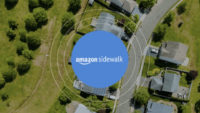Amazon Opens Low-Power Sidewalk Network to Developers
March 31, 2023
Amazon has opened Sidewalk, its low-power, wide-area network (LPWAN), to developers. Introduced in 2019, Amazon’s early focus was using Sidewalk to optimize Ring cameras and Level smart locks. The company quietly extended coverage to what it says is 90 percent of the U.S. population, and indicates it is now ready to connect “the next billion devices.” Sidewalk can be useful for a multitude of IoT devices that need Internet connectivity yet can’t always rely on a robust four-bar signal, or just don’t require a lot of bandwidth or power.
“Many types of connected devices have been limited by the range of Wi-Fi and the cost of cellular technology, which has hindered the ability to connect devices like environmental sensors, leak detectors, and smart locks. Sidewalk is designed to provide a secure, low-cost way to invent and connect a whole new range of devices,” Amazon SVP devices and services Dave Limp said in an announcement.

Sidewalk access is free for customers (and developers). Though it does require an ISP, it’s a “community network,” meaning those who opt-in agree to share a slice of their Internet connectivity with neighbors’ Sidewalk-enabled devices in exchange for the same privilege. Amazon has said Sidewalk will never siphon off more than 500MB per month.
“It’s kind of genius and also literally something only Amazon could do at this scale. What other company has thousands of connected devices in people’s homes?” writes The Verge, explaining that it works on three existing wireless radio frequencies — “Bluetooth Low Energy (BLE) for short distances, LoRa for long range, and frequency-shift keying (FSK) using 900MHz.”
These frequencies can connect to the Internet using any accessible Sidewalk gateway, “including Echo Show 10, Echo, Echo Dot smart speakers, and wired Ring spotlight and floodlight cameras, as well as a small number of commercial grade bridges,” according to The Verge.
Amazon is making Sidewalk test kits broadly available to devs on request. The company has also rolled out a consumer page. Software and hardware developer kits are being distributed free by Nordic Semiconductor, Silicon Labs, Texas Instruments and Quectel. Mobile SDKs for Android and iOS are delivered by Amazon directly, via GitHub.
Sidewalk is compatible with the Matter global IoT standard. When it comes to low-powered device extenders, Sidewalk is not the only option. The Verge says “Z-Wave has a long-range chip that can extend connectivity over 300 feet, and Thread is a low-power mesh network that could extend beyond your home’s walls into the garden or garage with enough devices. But neither of these offers the mobility of Sidewalk.”
Amazon says Sidewalk can extend a low-powered mobile signal up to a half mile, making it ideal for things like health monitors, package trackers and pet finders.

No Comments Yet
You can be the first to comment!
Leave a comment
You must be logged in to post a comment.